| Columns Retired Columns & Blogs |
What would happen if you take into consideration the Bryston's higher gain? And why it is unfair to have higher gain ?
The input impedance of the Bryston measured just over 33k ohms at the balanced inputs, just over 47k ohms at the unbalanced. Measured voltage gain into an 8 ohm load was 30.2dB in either configuration. (Normally, there is 6dB greater gain in a balanced configuration.) The measured output impedance of the Bryston was under 0.06 ohms at or below 1kHz, increasing to a maximum of 0.13 ohms at 20kHz, which is still very low. DC offset measured 16.3mV in the left channel, 16.7mV in the right. Signal/noise (wide-band, unweighted at 1W into 8 ohms) measured 67.7dB balanced, 75.4dB unbalanced, an unexpected result perhaps caused by additional circuitry in the balanced configuration. The 4B was noninverting with pin 3 of the balanced input configured as the positive leg, pin 2 the negative, this the opposite of the IEC recommended practice.
Fig.1 shows the frequency response of the 4B through the unbalanced input. There is a slight but inconsequential difference in ultrasonic rolloff into 4 ohms compared with 8. Through the balanced input (not shown), the rolloff at the very top end was slightly less—a maximum of –0.7dB at 50kHz (2W into 4 ohms). There was also slightly less rise in the frequency response at 20kHz through the balanced input, but we're talking here of a matter of 0.1dB. The 10kHz squarewave response is shown in fig.2. The Bryston has a short risetime with a very slight overshoot at the leading edge, this perhaps correlating with the slight rise at 20kHz into 8 ohms.
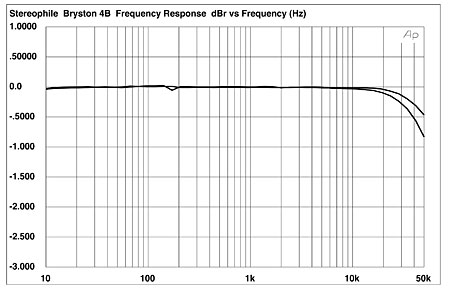
Fig.1 Bryston 4B, frequency response at 2.83V into 8 oms (top) and 4 ohms (bottom) (0.5dB/vertical div.).
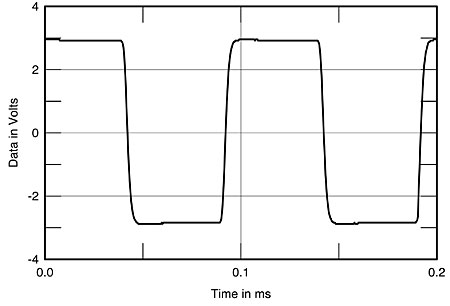
Fig.2 Bryston 4B, small-signal 10kHz squarewave into 8 ohms.
Fig.3 shows the crosstalk for both the balanced and unbalanced inputs. Though the worse performance is for the left-to-right crosstalk from the balanced input (output from the right channel for an input to the left), the differences are unlikely to have any audible consequences. The increase in crosstalk with increasing frequency is a typical result of capacitive coupling between channels.
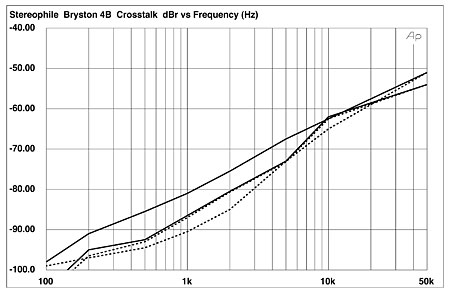
Fig.3 Bryston 4B, crosstalk (from top to bottom): L–R, R–L, balanced; R–L, L–R, unbalanced (10dB/vertical div.)
Fig.4 shows THD+noise vs frequency for the unbalanced mode. The results for the balanced input (not shown) were only marginally different—above about 5kHz, the differences between the balanced and unbalanced inputs were less than 0.001% (with the unbalanced higher). Below that, the balanced readings were higher by the same amount, but without the slight roughness noted below 1kHz in the plot shown. The waveform of the THD+noise, not shown, was random in nature at these levels, the absence of obviously dominant harmonics implying that the traces in fig.4 are mainly noise.
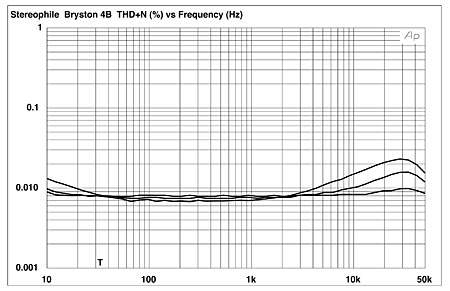
Fig.4 Bryston 4B, THD+N (%) vs frequency at 2.83V into (from bottom to top): 8, 4, 2 ohms.
The spectrum of the 4B's output when driving a 50Hz signal into a 4 ohm load at 267W (2/3 power) is shown in fig.5. The distortion components here are well down in level—in the worst case greater than –100dB, or 0.001%. Fig.6 shows the spectrum of the 4B's output when reproducing a combined 19+20kHz signal at 193W output into 4 ohms (just below visible signs of clipping at this frequency). The highest artifact here is at about –85.6dB at 21kHz: 0.005%. The corresponding data for an 8 ohm load (at 136W, not shown) are comparable if in general slightly higher; for example, 0.008% at 21kHz and 0.006% at 1kHz.
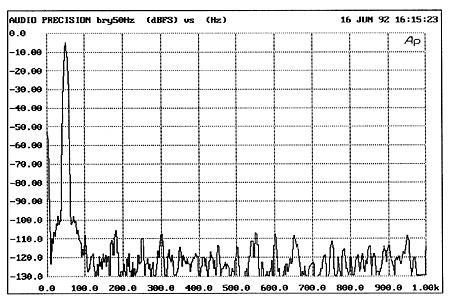
Fig.5 Bryston 4B, spectrum of 50Hz sinewave, DC–1kHz, at 267W into 4 ohms (linear frequency scale).
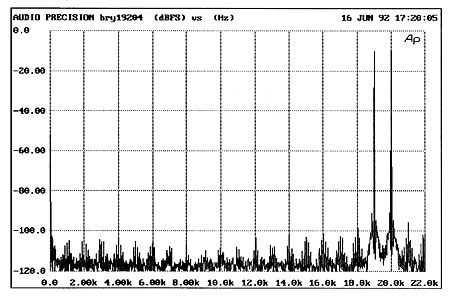
Fig.6 Bryston 4B, HF intermodulation spectrum, DC–24kHz, 19+20kHz at 386W peak into 4 ohms (linear frequency scale).
The Bryston is a powerful amplifier, rated at 250Wpc into 8 ohms (24dBW) and 400W into 4 ohms (23dBW) on a continuous basis. The THD+noise vs level curves for the 4B are shown in fig.7. Note that the maximum output drops for a 2 ohm load, implying that the amplifier is current-limited. The actual discrete clipping measurements were 254.1W/254.4W (24dBW, left/right, 110V line), both channels driven, and 271.5W (24.3dBW, 113V line) with a single channel driven into 8 ohms; 356.5W/351.7W (22.5dBW, left/right, 108V line), both channels driven, and 373.1W (22.7dBW, 111V line) with a single channel driven into 4 ohms; and 218W (17.4dBW) into 2 ohms, one channel driven. The last reading, especially, was somewhat unstable, changing as the amplifier significantly heated up over the brief period in which a driving signal was applied (footnote 1).
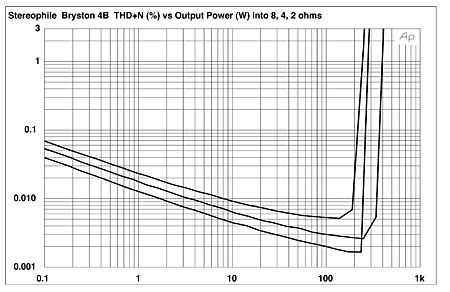
Fig.7 Bryston 4B, distortion (%) vs 1kHz continuous output power into (from bottom to top at 100W): 8, 4, 2 ohms.
Altogether, the Bryston 4B's measurements were excellent—as one would expect of a modern, solid-state amplifier designed for high power, low distortion, and a low output impedance.—Thomas J. Norton